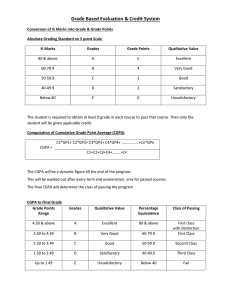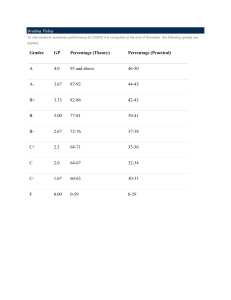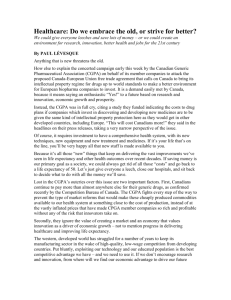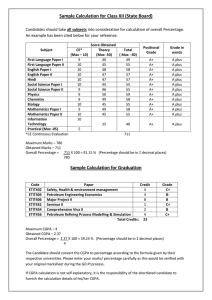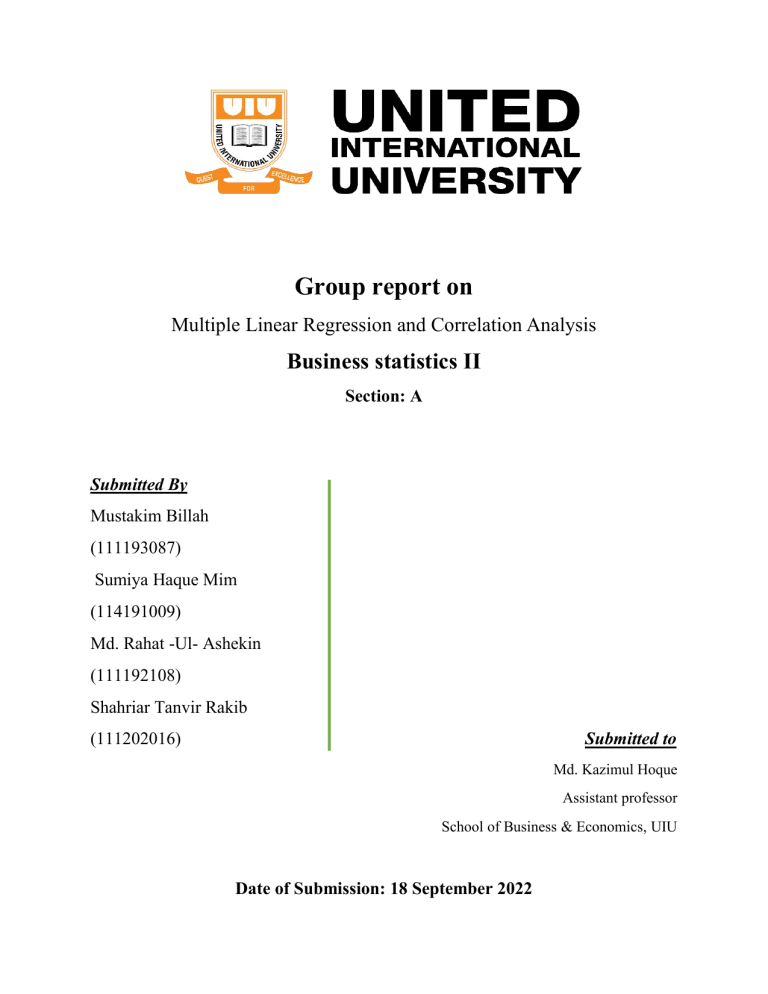
Group report on Multiple Linear Regression and Correlation Analysis Business statistics II Section: A Submitted By Mustakim Billah (111193087) Sumiya Haque Mim (114191009) Md. Rahat -Ul- Ashekin (111192108) Shahriar Tanvir Rakib (111202016) Submitted to Md. Kazimul Hoque Assistant professor School of Business & Economics, UIU Date of Submission: 18 September 2022 Developed questionnaire for the survey: 1.What is your average grade point till now? less than 2 2-2.5 2.5-3 3-3.5 3.5-4 2. How many classes do you miss missed less than 2 classes missed up to3-4 classes missed up to 5-6 classes missed up to 7-8 classes more 3. How much do you time spend on studying? less then .5 hours .5-1 hours 1-1.5 hours 1.5-2 hours over 2 hours 4. How much motivated do you feel while studying? highly motivated .( I am extremely curious to learn.) moderately motivated. ( I feel sufficient amount of motivation) average. (my study time is not enough to motivate myself.) less motivated. (my study time is not enough to motivate myself.) not motivated. ( I don't study at all) 5. How much stressful do you feel to study? high stress.( I feel extremely stress while studying.) moderate stress. (I feel noticeable amount of stress while studying.) average stress. ( I feel some stress while studying.) less stress. (I feel a little stress, but it's okay.) no stress. ( I don't feel any stress at all) 6. How much engagement do you feel towards your courses? highly engagement . ( I am extremely curious to learn.) moderate engagement.(I find sufficient amount of motivation) average engagement. ( I find some courses interesting) less engagement. ( I find only few courses boring) no engagement. ( I don't find any courses interesting) Survey data: Student no. 1 2 3 4 5 6 7 8 9 10 11 12 13 14 15 16 17 18 19 20 21 22 23 24 25 26 27 28 29 30 CGPA Study time 4 5 4 4 5 3 4 5 2 4 5 3 3 4 5 4 2 4 5 4 3 5 5 2 4 3 5 3 4 5 Motivation 3 3 4 3 4 2 3 5 1 5 5 3 2 4 3 5 1 3 4 4 4 5 4 1 5 2 5 3 2 4 3 3 3 4 4 1 3 4 1 3 5 2 3 4 3 4 2 5 5 4 4 4 5 2 5 2 4 3 3 5 Engagement toward courses 4 4 3 3 4 1 4 4 1 4 4 2 4 4 4 4 1 4 4 4 3 4 4 1 5 1 4 3 3 4 Stress level Attendance 2 1 3 2 3 5 2 1 4 3 1 4 3 2 2 3 5 2 2 1 3 3 1 5 4 5 2 3 1 2 4 5 5 3 5 2 3 5 1 5 J5 3 4 5 4 4 1 5 4 5 4 5 5 3 5 3 5 3 4 4 Findings: Descriptive Statistics Mean Std. Deviation N cGPA 3.93 .980 30 Study_time 3.40 1.276 30 Motivation 3.30 1.179 30 Attendance 3.43 1.165 30 Stress 2.67 1.295 30 Attitude 3.97 1.189 30 Comment: We have taken 30 samples in total. The mean cGPA of 30 samples scores 3.93 in a 15 range of scale, indicating the mean students are having a cGPA of just below 3.00. The standard deviation for cGPA is 0.980, which indicated that 68% of the data are clustered very closely around the mean score. Correlations cGPA Pearson Correlation cGPA Attendance Stress Attitude .739 .794 .721 -.751 .768 Study_time .739 1.000 .766 .738 -.480 .782 Motivation .794 .766 1.000 .806 -.723 .820 Attendance .721 .738 .806 1.000 -.632 .733 -.751 -.480 -.723 -.632 1.000 -.635 .768 .782 .820 .733 -.635 1.000 . .000 .000 .000 .000 .000 Study_time .000 . .000 .000 .004 .000 Motivation .000 .000 . .000 .000 .000 Attendance .000 .000 .000 . .000 .000 Stress .000 .004 .000 .000 . .000 Attitude .000 .000 .000 .000 .000 . cGPA 30 30 30 30 30 30 Study_time 30 30 30 30 30 30 Motivation 30 30 30 30 30 30 Attendance 30 30 30 30 30 30 Stress 30 30 30 30 30 30 Attitude 30 30 30 30 30 30 Attitude N Motivation 1.000 Stress Sig. (1-tailed) Study_time cGPA Comment: The strongest correlation of the dependent variable cGPA is with the independent variable Motivation. So, among all the factors, the level of Motivation a student is having is the strongest influencer of the student’s performance. Here, as the value is positive (0.739), we can say there is a direct positive relationship between these two variables. It seems obvious, because the more motivation a student feels towards her study, the better cGPA she will be able to achieve. Model Summary Model 1 R R Square .874 Adjusted R Std. Error of the Square Estimate .764 a .715 Change Statistics R Square Change .523 F Change .764 df1 15.567 df2 5 Sig. F Change 24 a. Predictors: (Constant), Attitude, Stress, Attendance, Study_time, Motivation Comment: R is the correlation between the predicted values and the observed values of the dependent variable (Here, cGPA). As the value is positive and close to 1.00, there is a strong direct relationship between the actual and observed values. R square is the square of this coefficient and indicates the percentage of variation in the dependent variable explained by the variation in the dependent variables. Here the adjusted R square value (which is more accurate than R square) indicates that the 5 independent variables altogether are explaining 76.4% of the data in the the variation of cGPA of a typical student. The rest of 23.6% of the variation in cGPA can be explained by the presence of some controlled variables or some insignificant variables. ANOVAa Model 1 Sum of Squares Regression Residual Total df Mean Square 21.299 5 4.260 6.568 24 .274 27.867 29 a. Dependent Variable: cGPA b. Predictors: (Constant), Attitude, Stress, Attendance, Study_time, Motivation F 15.567 Sig. .000b .000 Comment: Here, the calculated F value 15.567 indicates a P value which is very close to 0, ( Far less than the significance level 0.05). So we reject the null hypothesis. Coefficientsa Unstandardized Coefficients Model 1 B Std. Error (Constant) 3.045 .723 Study_time .251 .140 Motivation .090 Attendance Stress Attitude Standardized 95.0% Confidence Interval for Coefficients B Beta t Sig. Lower Bound Correlations Upper Bound Zero-order Partial Part 4.211 .000 1.553 4.538 .326 1.790 .086 -.038 .540 .739 .343 .177 .188 .108 .475 .639 -.299 .478 .794 .097 .047 .026 .151 .031 .174 .864 -.286 .339 .721 .035 .017 -.307 .114 -.406 -2.699 .013 -.542 -.072 -.751 -.483 -.267 .118 .161 .143 .736 .469 -.213 .450 .768 .149 .073 a. Dependent Variable: Cgpa Comment: Here, the regression equation will be: Y= 3.045+ 0.251 x^1 + 0.090x^2+ 0.026x^3- 0.307x^4+ 0.118x^5 Here, the regression coefficient of mean study time is 0.251. The coefficient is positive and shows a direct relationship between cGPA and Study time. As the study time increases, the cGPA of a student increases. Here, like the study time, Motivation, Attendance and Attitude toward study are also having direct positive relationship with cGPA; indicating the more Study time, Motivation, Attendance and Attitude a student is having, better she will be able to achieve a good grade. Among the five independent variables, only Stress Level has a negative coefficient value, indicating an indirect relationship between stress and cGPA. It is also obvious, because more stress a student is having in her study life, the more difficulties she will be facing to achieve a good grade. Reference: http://article.scieducationalresearch.com/pdf/EDUCATION-2-9-8.pdf


